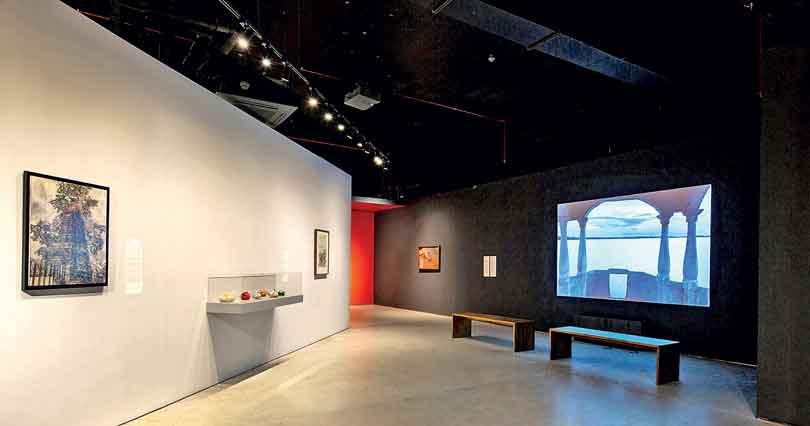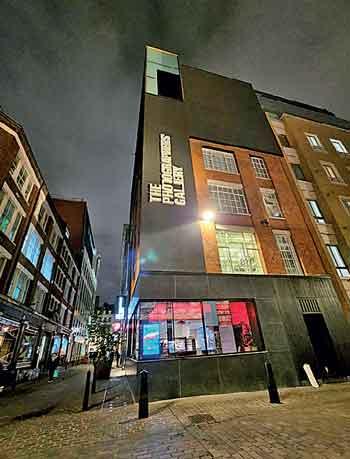
The Museum of Modern and Contemporary Art Sri Lanka (MMCA Sri Lanka), held their first international art event ‘The Foreigners — Sri Lankan Contemporary Video Works and Panel Discussion’ during Frieze week, (London’s largest art fair) at The Photographers’ Gallery, in London.
 The Museum of Modern and Contemporary Art Sri Lanka (MMCA Sri Lanka), held their first international art event ‘The Foreigners — Sri Lankan Contemporary Video Works and Panel Discussion’ during Frieze week, (London’s largest art fair) at The Photographers’ Gallery, in London.
The Museum of Modern and Contemporary Art Sri Lanka (MMCA Sri Lanka), held their first international art event ‘The Foreigners — Sri Lankan Contemporary Video Works and Panel Discussion’ during Frieze week, (London’s largest art fair) at The Photographers’ Gallery, in London.
The event took the form of discussions that addressed the entangled subject of foreignness through video works by contemporary Sri Lankan artists Dinelka Liyanage, Hania Luthufi, Imaad Majeed, Nina Mangalanayagam and Sumudi Suraweera . The videos were followed by a discussion moderated by curator, writer, and researcher Hammad Nasar MBE, alongside Nina Mangalanayagam, Reginald S. Aloysius, Sandev Handy (Curator, MMCA Sri Lanka) and Sharmini Pereira (Chief Curator, MMCA Sri Lanka). The well attended event raised many questions about our own attitudes and feelings of foreignness.
 Q: How long did it take to put this exhibition together?
Q: How long did it take to put this exhibition together?Sharmini Pereira: Work on ‘The Foreigners’ took a year and a half, and involved a very tight schedule with much shorter than normal time frames to secure all the loans for the exhibition. Curating the artworks for our event at The Photographers’ Gallery in London took much less time since we made the decision to screen all the video works that are part of ‘The Foreigners’. However, this was a careful curatorial selection, made considering the thematics that we wanted to take to our international audiences in London, from ‘The Foreigners’ exhibition in Colombo.
Q: What were the criteria to select the artists that you have chosen?
Sandev Handy: ‘The Foreigners’ brings together the works of 15 contemporary artists, who use varying media to address the entangled ways in which foreignness is inscribed onto them, marking them as strangers, outsiders, or transgressors. They ask the question ‘does someone have to be from outside of this country in order to be called a foreigner?’ How do we break that down and moreover, how do we think about the inverse? Do you really need a passport, or an identity card or residency, or have a family here, or to be living here, to be considered to be “from” this country?’ The works from ‘The Foreigners’ which have been taken to London speak to the entangled experiences of foreignness; a subject at the forefront of discussions on migration, climate, and asylum across the world.
Q: Do you have plans to bring more art events like this abroad?
Sharmini Pereira: This is our first international event, which we chose to schedule during Frieze London, a time when the global art community converges in this city. Our hope in organising events like this is that they will effectively convey the nature of the work we are undertaking at the MMCA Sri Lanka. Therefore, I envision this event paving the way for more partnerships with other institutions in the UK. Such collaborations can help us in our mission to garner greater recognition for the many modern and contemporary artists who have connections with Sri Lanka.
Q: How can we promote our contemporary artists more?

Sharmini Pereira: The global recognition of Sri Lankan artists, and modern and contemporary art is a positive trend that has been steadily increasing, largely due to the growing attention towards South Asia. The region has been home to some of the most influential artists of the modern period, that is those working during the ’20s to the ’60s, and it continues to be a vibrant region with numerous contemporary artists and young curators. However, there is still much more work to be done. Within Sri Lanka itself, we have not done enough to showcase the work of our modern and contemporary artists. We must support and recognise the brilliant work being produced within our country, and encourage its preservation, collection, purchase, and presentation in curated exhibitions. Furthermore, we should engage in critical writing and discussions that place this art within broader conversations about why modern and contemporary art is significant in Sri Lanka, what defines it, the context in which it is created, and the challenges and opportunities that exist for these artists to share their work internationally.
Pix courtesy MMCA

 The Museum of Modern and Contemporary Art Sri Lanka (MMCA Sri Lanka), held their first international art event ‘The Foreigners — Sri Lankan Contemporary Video Works and Panel Discussion’ during Frieze week, (London’s largest art fair) at The Photographers’ Gallery, in London.
The Museum of Modern and Contemporary Art Sri Lanka (MMCA Sri Lanka), held their first international art event ‘The Foreigners — Sri Lankan Contemporary Video Works and Panel Discussion’ during Frieze week, (London’s largest art fair) at The Photographers’ Gallery, in London. Q: How long did it take to put this exhibition together?
Q: How long did it take to put this exhibition together? Sharmini Pereira: The global recognition of Sri Lankan artists, and modern and contemporary art is a positive trend that has been steadily increasing, largely due to the growing attention towards South Asia. The region has been home to some of the most influential artists of the modern period, that is those working during the ’20s to the ’60s, and it continues to be a vibrant region with numerous contemporary artists and young curators. However, there is still much more work to be done. Within Sri Lanka itself, we have not done enough to showcase the work of our modern and contemporary artists. We must support and recognise the brilliant work being produced within our country, and encourage its preservation, collection, purchase, and presentation in curated exhibitions. Furthermore, we should engage in critical writing and discussions that place this art within broader conversations about why modern and contemporary art is significant in Sri Lanka, what defines it, the context in which it is created, and the challenges and opportunities that exist for these artists to share their work internationally.
Sharmini Pereira: The global recognition of Sri Lankan artists, and modern and contemporary art is a positive trend that has been steadily increasing, largely due to the growing attention towards South Asia. The region has been home to some of the most influential artists of the modern period, that is those working during the ’20s to the ’60s, and it continues to be a vibrant region with numerous contemporary artists and young curators. However, there is still much more work to be done. Within Sri Lanka itself, we have not done enough to showcase the work of our modern and contemporary artists. We must support and recognise the brilliant work being produced within our country, and encourage its preservation, collection, purchase, and presentation in curated exhibitions. Furthermore, we should engage in critical writing and discussions that place this art within broader conversations about why modern and contemporary art is significant in Sri Lanka, what defines it, the context in which it is created, and the challenges and opportunities that exist for these artists to share their work internationally.